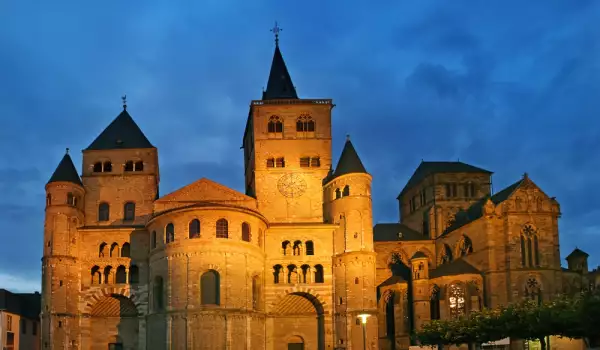Trier Cathedral

Trier Cathedral is located in the city of Trier in Germany. It bears the name of St. Peter. It is a symbol of the city. The ancient German city keeps inscription on one of their old houses, which reads: "Trier has stood 1 300 years before Rome and can stand still and enjoy the eternal world.”
In the early Middle Ages Trier was one of the most prosperous German cities and at that time was built the cathedral - it is the oldest of all German churches. Over fifteen hundred years it has carried out church services.
At first glance, the cathedral of Trier is not among the buildings that are breathtaking in their beauty. But the more one looks at the asymmetric accumulation of walls and towers, the more honor you give to the creators of the temple, they clearly wanted to unite elements of ancient architectural styles, characteristic of early Christianity. The Trier cathedral was built on the foundations of the former palace of the Empress Helen, who was the mother of Constantine the Great. During archaeological excavations, they have found many beautiful fragments of ancient paintings, which now adorn various museums around the world.
Some fragments of the structure were created at the time of antiquity and are included in the building of the cathedral. The Trier cathedral includes parts of the early Christian church built around 348 and remains of a Roman basilica, built around 385. The building of the cathedral is surrounded by built at different times and in different architectural styles of buildings from which the church seems quite unusual.

The Trier cathedral is a shining example of Romanesque architecture. Obviously, the cathedral was able to perform the role of refuge from enemies. Overall, the cathedral looks like a medieval knight's castle. The strict facade is brought alive by the semi-circular windows and arches with small galleries, but most likely these arches were not intended to decorate the temple and were for shooting with a bow. The castle is completed by two square towers that resemble small tents. The portals of the cathedral are decorated with several statues, which are very strict and there is nothing superfluous and picturesque.
The construction of the Cathedral is set in the forties of the eleventh century, when they began to expand the existing at that time the ancient Roman basilica. Twenty years later was completed the apse and in the twenties of the thirteenth century were made stone arches. The towers of the cathedral were built in the eleventh century. In the fourteenth century, the south tower of the cathedral was upgraded with a floor and was finished with a top like a tent.
In the seventeenth century, on the cathedral was placed a clock. The north tower of the temple has remained unchanged since its construction in the eighteenth century, the Trier bishops came to the conclusion that there are not enough decorations in the cathedral, and tried to remodel it in Baroque style. At the time, they made a splendid carved altar and they the altar wall with reliefs. New details in the interior were made during the first years of the twentieth century.
The corpse, which is located in the Cathedral, is placed in the temple in 1974. Among the relics of the temple is a tunic that belonged to Jesus Christ. It attracts many tourists and pilgrims to the temple. Since it is very old, it is shown to believers rarely - once every thirty years.
In the cathedral, there are the tombs of many bishops and German princes. In the early twentieth century the foundations of the cathedral were seriously threatened by groundwater and raised serious concerns about the fate of the temple. For the salvation of the building were hosted a number of activities.















